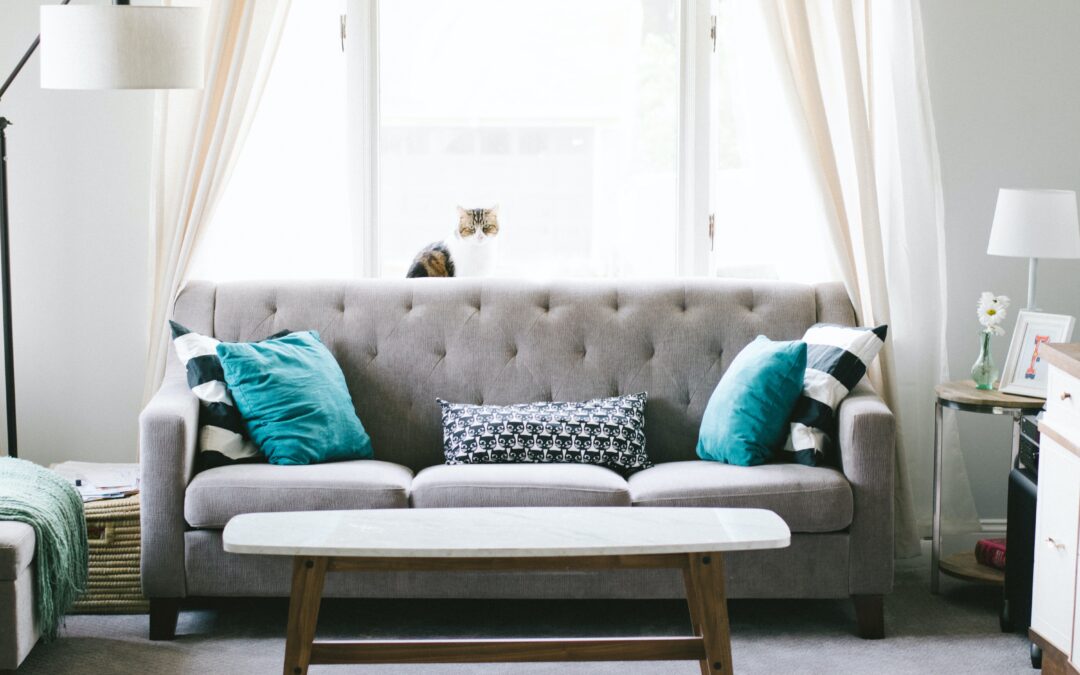Smaller properties may be more restrictive in size, but that certainly doesn’t mean they are more restrictive in style and furnishing possibilities. In this article, we want to give you some of the best tips on furnishing and setting up small places within your property.
Smaller properties, such as studio apartments or one-bedroom homes, rarely benefit from layout configurations which put an emphasis on space. This means that if you are a smaller property owner, or are looking to downsize, you may find yourself needing an extra spark of creativity to maximize your layout.
Making small spaces seem bigger than they actually are might appear to be a challenge, but there are numerous ways to overcome this.
Lighting
One of the most effective methods to maximize the size of a room is by utilizing light. When rooms use dark colour tones or don’t have access to natural light, they often feel much smaller than they actually are. By letting in as much natural light as possible, or using additional lighting throughout your space, your room will feel much more spacious.
Wall lighting, sconces and pendant lighting are much more effective uses of space, as they don’t intrude onto your floorplan.
Strategic Placement Of Larger Objects
The larger and bulkier an item is, the more space it will take up. When space is critical, it’s important to be strategic with the placement of larger furnishings. Placing them towards the perimeter of the room makes the space feel more open and accessible, particularly where sofas are concerned.
Just because a space is small, does not mean that you can’t include any larger furnishings in your layout. You just need to be mindful of the placement to maximize the space.
Utilize Folding/Multi-Purpose Furniture
When small spaces are concerned, there are furniture items that serve dual purposes. The rise in popularity and demand for compact living has meant that furniture makers have had to think outside the box in order to stay on-trend.
Loft beds are the perfect example, elevating your sleeping arrangements up off the floor so you can place storage, a desk or a sofa underneath. These are particularly popular in apartment-type properties and can be bought in a range of sizes. There are also plenty of foldable dining tables that can meet the demands of the space, as well as wall-mounted folding desks and more. Built-in storage such as wardrobes is also ideal to save space. They are commonly found as standard in apartments and condos.
Cut Out The Clutter
When we list properties to sell, we always advise our sellers to remove any clutter and ensure their home looks tidy and presentable. Not only is a clutter-free property easy for prospective buyers to imagine themselves living in, but it also creates more space and makes it feel larger.
Be mindful of leaving as much open space as possible in all visual areas, particularly surfaces. Stashing old envelopes, bills, and newspapers down the side of a sofa may not seem like a detriment to your space, but this type of clutter adds up and revokes any sense of a larger room.
Mirror Mirror On The Wall…
Mirror mazes at carnivals are the perfect example of how our perception of space can be altered. They take small spaces and amplify them significantly, and the same can be done within smaller properties.
Mirrors are able to reflect natural light back, essentially doubling the effect introduced by sunlight. In addition, they also help to make the smaller spaces seem larger. Clever utilization of mirrors can make them seem both artistic and contribute to maximizing the feeling of space in a smaller home.
The Right Rug
Rugs come in a huge variety of shapes and sizes, and picking the right one is more important than you might have thought.
Generally, the size of the rug reflects the size of a room. If you use a smaller rug, then it will make the room feel small. Larger rugs typically tend to make rooms feel larger. You should opt for rugs that furniture items can comfortably sit on and still be displayed, rather than rugs the size of small doormats. You can also use different rugs to separate certain areas of a single room, which is handy when there isn’t space for wall dividers.
Make The Most Of The Walls
No matter how limited your floor plan space is, you will generally have four walls. Use them!
Adding shelving provides storage without compromising too much on floor space. In addition, the higher you hang drapes or curtains, the larger the space will feel. Hooks are also an inexpensive and handy method of hanging items from your walls.
Adding pegs to your walls or the edge of shelving can also help to make hanging keys and such much tidier. A tidier home will feel like a larger home!
Contend With Angles
Small living spaces tend to be full of straight lines, with corners making it difficult to fit certain items. Corner furnishings have provided solutions on a number of occasions, but aren’t always the answer. When door frames, windows, and corners are within tight proximity, they can create a lot of harsh angles. Introducing curves, whether that be through rounded furniture or valances around windows, can help to break up these angles and introduce a flow to the room. In turn, this can help to make smaller spaces feel larger.
Get Colourful
Smaller spaces tend to lend themselves better to bolder color schemes. Whilst darker
colors can make rooms feel smaller, they also create a sense of intimacy. If you are looking to evoke a cosy feeling, a darker color palette is ideal.
On the opposite end of the scale, brighter and more uplifting colours can help to make smaller spaces feel much lighter and larger than they are. You should plan your colour schemes accordingly to determine the sense of space you wish to create. Interior design is key to maximize your space. You don’t need to be a qualified interior designer or even an architect to make efficient use of your home space.





